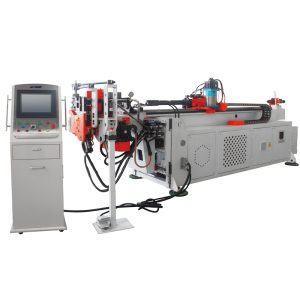One-stop Bending Solutions For Wires, Tubes And Pipes
One-stop Bending Solutions For Wires, Tubes And Pipes
Although fully automatic and semi-automatic pipe bending machines both belong to the category of pipe bending processing equipment, and their core function is to achieve angle shaping of pipes, the differences between them in technical architecture, operation mode, applicable scenarios, and overall benefits are essentially generational differences between automation technology and traditional processing methods, rather than fundamental changes in the products themselves. From the perspective of core drive and control logic, fully automatic pipe bending machines rely on a high-precision servo motor system to build their core control unit. Through preset programs, they precisely control key parameters such as feeding length, turning angle, and bending radius, achieving fully automated closed-loop operation from pipe feeding, multi-station continuous bending to finished product unloading. No manual intervention is required for intermediate measurement and adjustment, and the error of each processing step can be controlled within the micron range. Semi-automatic pipe bending machines, on the other hand, use hydraulic drive as their core power source. The thrust characteristics of the hydraulic system give them stable forming capabilities when bending at a single angle, but key steps such as feeding positioning and turning angle adjustment must rely on manual calibration using tools such as rulers and protractors. During processing, repeated stops are needed to measure and adjust parameters to complete multi-dimensional pipe forming.
The differences between the two are particularly significant in terms of product positioning and applicable processing scenarios. The fully automatic pipe bending machine is positioned for high-end industrial assembly line production, specifically designed for processing complex pipe shapes. Whether it’s multi-plane, multi-angle composite bending, precise forming of irregularly shaped pipes, or continuous processing of large batches of standardized products, its integrated automated process achieves “one-time feeding, full-process forming,” significantly shortening the processing cycle of a single pipe and effectively avoiding the cumulative errors caused by manual operation. It is especially suitable for fields with extremely high requirements for processing accuracy and production efficiency, such as automotive parts, aerospace components, and precision mechanical piping. In actual production scenarios, one operator can simultaneously supervise two or even more fully automatic pipe bending machines, monitoring the processing status in real time through a control console, greatly reducing the proportion of labor costs. Semi-automatic pipe bending machines are geared towards processing small to medium batches of simple pipe shapes. Their advantages lie in lower equipment purchase costs and lower operating thresholds, making them suitable for scenarios with relatively simple processing needs, such as pipes bent at a single angle, simple formed parts with two or fewer angles on the same plane, or small processing plants and repair workshops where processing volume is small and precision requirements are not stringent. However, when processing complex pipes, the limitations of semi-automatic pipe bending machines become apparent: since each bending angle needs to be measured and adjusted manually, not only is the processing efficiency low, but the instability of manual operation leads to inconsistent product precision. Usually, two or even three operators are needed to work together (one to feed the material, one to measure, and one to adjust the equipment) to barely complete the processing of complex pipes. The labor and time costs are much higher than those of fully automatic pipe bending machines.
It’s worth noting that in certain simplified processing scenarios, the performance difference between the two is significantly reduced. When the processing requirement is only for simple pipes of ordinary materials, and the bending process involves only a single angle or two angles within the same plane, the automation advantage of a fully automatic pipe bending machine is difficult to fully realize. In contrast, a semi-automatic pipe bending machine, with its lower equipment investment cost and more flexible operating modes, offers better cost-effectiveness. For example, in fields such as construction scaffolding pipe processing and daily hardware accessory production, where precision requirements are not high and processing procedures are simple, a semi-automatic pipe bending machine can meet basic processing needs more economically. In such cases, choosing semi-automatic equipment is more in line with the actual needs of production cost control.
In general, the difference between fully automatic and semi-automatic pipe bending machines lies essentially in the difference between “automated precision production” and “manually assisted semi-automated production” modes. There isn’t an absolute superiority or inferiority between the two; rather, it’s a differentiated choice based on different processing needs, production scales, and precision requirements. For those pursuing high efficiency, high precision, and large-volume production, fully automatic pipe bending machines are the preferred choice; for those focusing on low cost, small batches, and simple processing, semi-automatic pipe bending machines offer better value for money.
If you have any needs or questions regarding fully automatic or semi-automatic pipe bending machines, please feel free to contact us. We have professional sales staff ready to answer your questions.

Our equipment has CE, ISO quality inspection certificate, so the quality is guaranteed to be cost-effective. According to different processing requirements, machines can be customized to fit for your usage, to provide customized services. In the processing period, we strictly control the production process, to ensure the quality of clearance, standardize the process, strict implementation.
